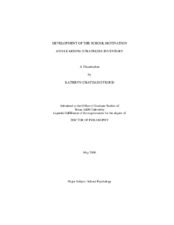| dc.description.abstract | The goal of this project was to develop a self-report inventory designed to assess
constructs associated with academic motivation and various learning strategies including
study strategies, time management, organizational techniques, attention and
concentration, writing and research skills, and test taking strategies. The School
Motivation and Learning Strategies Inventory (SMALSI) was developed in two forms,
Child and Teen, measuring 9 and 10 constructs, respectively. Following a survey of
available literature, items were constructed, subjected to review and revision, and then
field tested. Following analyses of internal consistencies, items were removed to
improve construct coherence. Revised forms were prepared and administered to a
standardization sample of 2921 students. Additional tests of internal consistency were
conducted and final versions were prepared for publication. Analyses suggest adequate
reliability for both forms of the SMALSI with great consistency across age, gender, and
ethnicity. Validity was assessed for 23 students completing the SMALSI Child Form and
24 students completing the SMALSI Teen Form using the Behavior Assessment System
for Children – Self-Report Profile. Student Liabilities scales were positively correlated
with measures of emotional, academic, and social maladjustment. In like form, Student Strengths scales were negatively associated with these measures. Interesting results were
also obtained specifically regarding the relationship of depression to learning strategies.
Validity was also assessed for 32 students completing the SMALSI Child Form and 53
students completing the Teen Form by obtaining Texas Assessment of Knowledge and
Skills (TAKS) scores. Results for several of the constructs indicated small to moderate
correlations in the expected direction. Guidelines for interpretation of the ten SMALSI
constructs were presented along with suggestions for further investigation, including the
use of clinical populations and standardized measures of achievement. | en |


